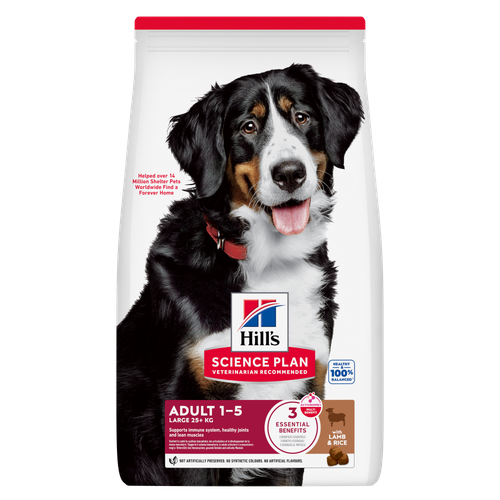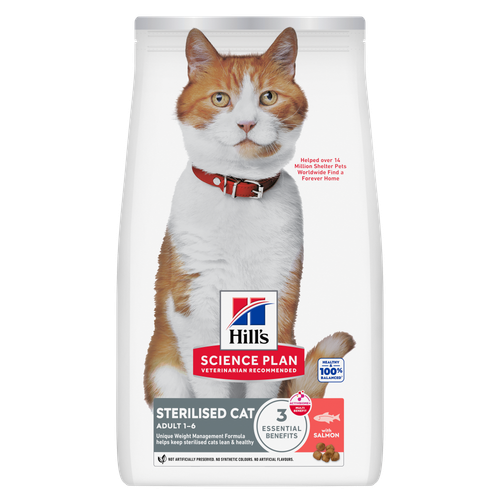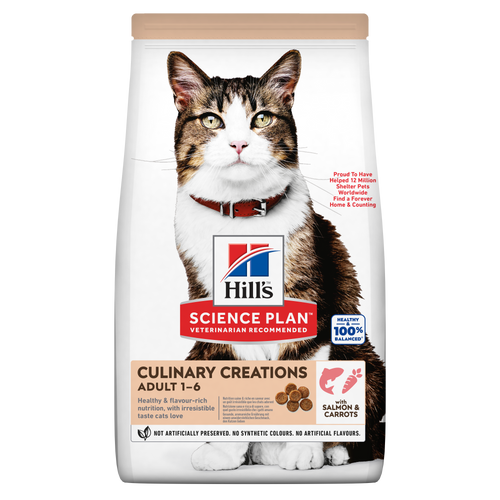
-
Find the right food for your petTake this quiz to see which food may be the best for your furry friend.Find the right food for your petTake this quiz to see which food may be the best for your furry friend.Featured products
 Perfect Digestion Large Breed Puppy Food
Perfect Digestion Large Breed Puppy FoodPrecisely balanced nutrition with Hill's ActivBiome+ prebiotic blend actively contributes to supporting digestive health and overall wellbeing to help your pet feel their best
Shop Now Adult Light Dog Food
Adult Light Dog FoodHill's Science Plan Light Adult Wet Dog Food is a complete premium pet food for adult dogs that tend to gain weight easily. This deliciously smooth loaf is formulated to deliver the appropriate amount of energy to support weight maintenance in adult dogs.
Shop Now Large Breed Adult Dog Food
Large Breed Adult Dog FoodHill's Science Plan Large Breed Adult Dog Food with Lamb & Rice is a complete pet food, specially formulated with ActivBiome+ Multi-Benefit Technology.
This food is specifically designed to fuel the energy needs of large breed dogs during the prime of their life.Shop NowFeatured products Sterilised Adult Cat Food
Sterilised Adult Cat FoodHill's Science Plan Adult Sterilised Cat Dry Food with Salmon is specially formulated with ActivBiome+ Multi-Benefit Technology. It is a precisely balanced nutrition, tailored to meet the needs of sterilised cats, to help keep sthem lean & healthy.
Shop Now Adult Cat Food
Adult Cat FoodHill's Science Plan Adult Cat Food with Chicken is a complete pet food, specially formulated with ActivBiome+ Multi-Benefit Technology.
This food is specially formulated to fuel the energy needs of cats during the prime of their life.Shop Now CULINARY CREATIONS ADULT CAT FOOD
CULINARY CREATIONS ADULT CAT FOODHill's Science Plan CULINARY CREATIONS Adult cat food with Salmon & Carrots was formulated to provide a great-tasting experience to cats. Its delicious flavour and texture are combine with essential nutrients to support cats' optimal health during the prime time of their life. Specially formulated with high-quality salmon protein, essential taurine for heart health & balanced minerals to support kidneys & bladder.
Shop Now -
Dog
- Dog Tips & Articles
-
Health Category
- Weight
- Food & Environmental Sensitivities
- Urinary
- Digestive
- Joint
- Kidney
-
Life Stage
- Puppy Nutrition
- Adult Nutrition
- Senior Nutrition
Cat- Cat Tips & Articles
-
Health Category
- Weight
- Skin & Food Sensitivities
- Urinary
- Digestive
- Kidney
-
Life Stage
- Kitten Nutrition
- Adult Nutrition
Featured articles Microchipping: The Facts | Hill's Pet
Microchipping: The Facts | Hill's PetThe government has announced that as of April 2016, all dogs in the UK must be microchipped by law.
Read More Pet Nutrition: What Makes "Healthy" Pet Food Healthy? | Hill's Pet
Pet Nutrition: What Makes "Healthy" Pet Food Healthy? | Hill's PetIn people, the right diet is very important. If you are eating the wrong way for your metabolism, activity level, age and lifestyle you could end up with health issues.
Read More The Incredible Science Behind Your Pet's Microbiome
The Incredible Science Behind Your Pet's MicrobiomeLearn what your pet's microbiome is, how it contributes to your pet's gut and overall health, and why nutrition is important in maintaining healthy microbiomes.
Read More -


As a cat parent, cleaning out the litter box may not be one of your favourite activities (if it is, we have plenty of litter boxes for you here!). But checking cat poo to ensure it's a normal colour and shape is one of the ways you can spot signs of possible health problems.
Most cats poo at least once a day, and cat stool is a great indicator of your cat’s state of health. It can tell you if they are experiencing stress or an underlying illness, or if their cat food isn't agreeing with them.
By familiarising yourself with what "good poo" looks like, you can ensure that you're equipped to recognise when their stool doesn't seem normal. Of course, lots of us pet parents don’t have litter trays and virtually never see our cats’ poo because they go outside to go to the toilet. If this is the case, you can still look out for changes in how often your cat goes out or whether you notice soft or runny poo around their rear end. If you’re ever suspicious of problems, you can offer a litter tray and see for yourself.
Healthy vs. Unhealthy Cat Poo: What to Look For
Healthy poo is generally malleable (like modelling clay: not too soft, not too hard). This is considered the gold standard and is a sign your cat is passing their stool normally. Healthy stool is dark brown in colour, but not too dark, as blackish poo can mean blood in the stool. Poo that is too light also may indicate a more serious issue like liver disease, as it can be an indication that the bile duct is obstructed, says the Merck MSD Veterinary Manual.
Small, hard balls of poo are considered abnormal and unhealthy because they can be an indicator of constipation. This is a serious issue for cats because it may indicate problematic health concerns like neurological or metabolic conditions or a colon obstruction, notes International Cat Care (ICC). They add that constipation may also be a sign that your cat is dehydrated. You should definitely call your vet if your cat passes small, hard balls of stool.

You should also be on the lookout for soft or liquid-like stools that have no discernible shape. Cat diarrhoea is caused by a variety of things, from viral infections to intestinal parasites to food intolerance. If you aren't looking closely, you may mistake liquid stool for urine. Make sure you always take a good, close look at what you're scooping or use a pair of disposable gloves to test the texture.


Tasty Tips
Not all unusual cat poo is cause for panic, but it does require careful observation. The PDSA says it’s common for cats to have diarrhoea after a change in food, for example. But if this type of stool persists for more than 24 hours or is accompanied by vomiting, lethargy or bloody stools, they recommend taking your cat to the vet. It's better to be on the safe side.
Preparing Cat Stool Samples
At each annual visit, your vet will ask for a stool sample so the lab can perform tests on the faecal matter. Samples are best collected in approved plastic containers, which your vet's office will provide. But you also can pick up a container at the office before your appointment, or purchase one online or at a pet supply shop. Just remember: the lab will need a fresh sample, so it's important not to collect your treasure from the litter box until the day that you drop it off at the vet. Once you scoop the faecal matter into the approved plastic sample container, refrigerate if it’s possible and make sure to jot down the date and time of collection so the vet's office has accurate information.
Multiple Cats, Multiple Checks
If you have more than one cat, you do not necessarily have to collect a sample from each individual animal unless your vet specifically asks you to do so. If you find bloody stool, though, you'll probably have to be on litter box patrol to determine which cat may be experiencing a health issue. Of course, if one cat is ill, the others may be too. If you notice a serious issue with one cat, try to isolate them with their own litter box until you can bring them to the vet.
Believe it or not, your cat's stool can tell you a lot about their wellbeing. By incorporating a stool check into your daily litter box maintenance routine, you can help to keep them in tip-top shape and provide them with a clean, healthy environment.


Christine O'Brien is a writer, mom, and long-time cat parent whose two Russian Blues rule the house. Her work also appears in Care.com, What to Expect, and Fit Pregnancy, where she writes about pets, pregnancy, and family life. Find and follow her on Instagram and Twitter @brovelliobrien.
Related products

Hill's Science Plan Adult Cat Food with Chicken is a complete pet food, specially formulated with ActivBiome+ Multi-Benefit Technology.
This food is specially formulated to fuel the energy needs of cats during the prime of their life.

Hill's Science Plan Adult Sterilised Cat Dry Food with Salmon is specially formulated with ActivBiome+ Multi-Benefit Technology. It is a precisely balanced nutrition, tailored to meet the needs of sterilised cats, to help keep sthem lean & healthy.

Hill's Science Plan Mature Adult Cat Food with Chicken is a complete pet food, specially formulated with ActivBiome+ Multi-Benefit Technology.
This food supports graceful aging in cats, providing a synergistic ingredient blend to help support energy & activity levels.

Hill's Science Plan CULINARY CREATIONS Adult cat food with Salmon & Carrots was formulated to provide a great-tasting experience to cats. Its delicious flavour and texture are combine with essential nutrients to support cats' optimal health during the prime time of their life. Specially formulated with high-quality salmon protein, essential taurine for heart health & balanced minerals to support kidneys & bladder.
Related articles

Just like people, cats can experience occasional stomach upset. If your cat exhibits any of the following, especially after eating, she may have a sensitive stomach.

Cats with sensitive skin have special needs and even healthy cats can sometimes develop poor skin health. Learn more about sensitive skin symptoms in your cat, what you can do to help your pet feel more comfortable and get recommendations on sensitive skin cat food.

Understand common skin issues in cats and how to manage them effectively. Learn signs and prevention, and get care tips. Find out more at Hill's Pet.

Learn about the causes of cat dermatitis, how to spot the symptoms and the best treatment options. Visit Hill's Pet for detailed guidance and tips.

Put your cat on a diet without them knowing
Our low calorie formula helps you control your cat's weight. It's packed with high-quality protein for building lean muscles, and made with purposeful ingredients for a flavourful, nutritious meal. Clinically proven antioxidants, Vitamin C+E, help promote a healthy immune system.
Put your cat on a diet without them knowing
Our low calorie formula helps you control your cat's weight. It's packed with high-quality protein for building lean muscles, and made with purposeful ingredients for a flavourful, nutritious meal. Clinically proven antioxidants, Vitamin C+E, help promote a healthy immune system.

